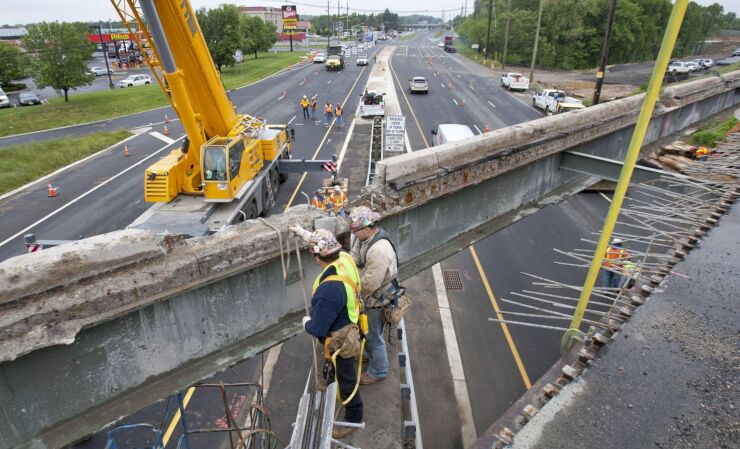The New Jersey Turnpike Authority’s first toll increase in eight years and new commitment to future incremental rate hikes marks a sharp policy departure as the 69-year old agency tackles a new long-range capital program.
NJTA commissioners voted unanimously May 27 to raise tolls 36% on the New Jersey Turnpike and 27% on the Garden State Parkway to help finance $24 billion in construction projects over the next 20 years.

The toll resolution also included initial approval to raise toll rates annually starting in 2022 at an undetermined index with a 3% annual cap.
The toll rate increase that takes effect Sept. 13 is only the fourth for the parkway since it opened in 1954 and the eighth for the turnpike since debuting in 1951.
New Jersey Gov. Phil Murphy approved the toll rate plan in advance of the vote, removing the risk of a veto.
“This will help them get away from the political drama of rate increases,” said Moody's Investors Service analyst John Medina. “It is a credit positive step.”
The NJTA last raised toll rates in 2012 at 53% on the turnpike and 50% on the parkway. Before that, there was a 2008 increase of 40% on the Turnpike and 43% on the Parkway. These two phased toll rate increases funded a 10-year $7 billion capital improvement plan.
The NJTA also implemented two toll rate increases in 2001 and 2003 that coincided with its transition to the E-ZPass automated toll collection system. The 2001 hike was the NJTA’s first since 1991 on the turnpike.
Medina said the turnpike authority’s plan for incremental yearly toll increases is a credit positive development because it paves the way for the agency to achieve toll-setting autonomy while potentially avoiding political and user pushback that comes from occasional large increases.
Medina said the policy requiring approval from the governor resulted in infrequent toll rate increases.
Moody’s rates NJTA debt A2 with a stable outlook. The agency is rated A by Fitch Ratings and A-plus by S&P Global Ratings with stable and negative outlooks, respectively.
Medina noted that about two-thirds of the toll enterprises Moody’s rates already use an indexed approach to rate increases. He said Florida has the best toll rate approach in the country thanks to a recently enacted policy requiring that toll rates be adjusted by at least the consumer price indexes once every five years on state toll roads.
“It a more credit positive toll rate regime more in line with the market lately with all new toll roads that are mostly all open road tolling,” Medina said. “If New Jersey can get anywhere close to their plan for indexed tolls it is very positive for them."
The NJTA has not yet decided on the index it will use for the toll increases. Medina cautioned that the federal Consumer Price Index may not increase enough to match revenues with annually rising costs for operations, maintenance and capital expenditures.
Traffic dropped sharply on the authority's toll roads because of the COVID-19 pandemic; traffic and revenue on both systems were down more than 60% year-over-year in April. Medina said traffic will likely recover over time, but struggle in the near-term while the coronavirus health crisis drives more people to work from home.
The financial hit from COVID-19 spurred a plan to privately place roughly $259 million of turnpike revenue bonds to refund outstanding debt with principal payments due in 2020 and 2021.
That deal was slated for this month. Diane Gutierrez-Scaccetti, who chairs NJTA’s board of commissioners, said in late May the transaction is designed
Municipal bond analyst Joseph Krist said that while the NJTA is well positioned with rate increases for the next two years, future political uncertainties could hamper the annual indexed hikes planned to begin in 2022.
Krist said if New Jersey remains in an economic downturn next year legislators who are facing reelection in 2021 may feel pressured to oppose additional toll hikes and try to thwart the plan.
“Politicians love to rail against toll increases,” said Krist, noting that many lawmakers called for Murphy to veto the NJTA toll hike this year before the Democratic governor signed off on the plan. “This will make for a challenging environment.”
The NJTA’s last two-phased rollout of toll increases in 2008 and 2012 netted a 69% revenue increase between 2009 and 2018 despite the number of transactions only jumping 3.8%, according to a January report from the American Transportation Research Institute. The ATRI analysis also showed 36.7% of the NJTA’s tolls are collected from non-New Jersey residents. The turnpike is a key highway artery for the northeast.
“With the exception of the recent months, traffic has been very stable,” said Jonathan Peters, a finance professor at the College of Staten Island, who co-authored the ATRI report. “They have had a very sustainable revenue stream for the past 50 years.”
The ATRI noted that the NJTA has often diverted toll revenues for other state funding needs including $179.5 million in 2019. Peters said the NJTA should be more transparent about where it plans to allocate future toll revenues and also questioned the timing of the 2020 rate increases when there was little public input because of the pandemic, with hearings held online.
“The regular increases will make it easier for the authority to spend money, but I question the justification for higher tolls and how the funds are being spent,” Peters said. “Toll road users are expected to pay about one billion dollars extra over five years to support state programs — above and beyond the cost of operating the road.”
The NJTA press office did not respond for comment on the agency’s toll hike plan. Some of the
The NJTA last entered the public debt market in January 2019 with a $449.1 million revenue bond deal led by Citi to fund final stages of the 10-year capital program. The agency has around $11 billion in outstanding debt.





